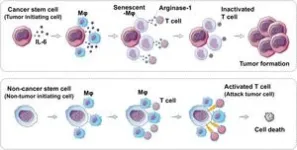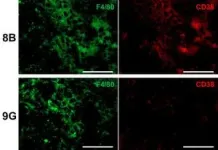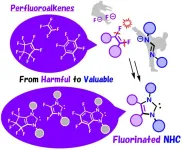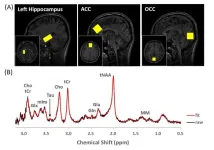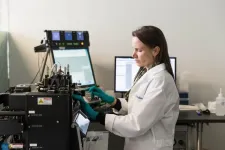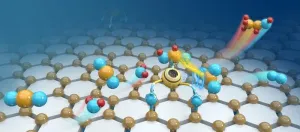(Press-News.org) Cancer stem cells cause the aging of macrophages in mice with healthy immune systems, creating conditions for the formation of tumors.
Cancerous tumors consist of a mixture of cells, the most important of which are cancer stem cells. These cells are capable of establishing new cancerous tumors by evading the immune response. Research has focused on identifying biomarkers for cancer stem cells and developing therapies that target these cells. Unfortunately, candidate drugs developed from these efforts have so far not been very effective in clinical trials.
A research team led by Associate Professor Haruka Wada at Hokkaido University’s Institute for Genetic Medicine examined the mechanisms by which cancer stem cells evade immune response in mice models. They showed that cancer stem cells induce senescence in macrophages—the immune cells which are responsible for the first step of the destruction of cancer cells. Their findings were published in the Journal for ImmunoTherapy of Cancer.
“One of the biggest questions in the development of cancer is how cancer develops in individuals with a healthy immune system,” explains Wada. “The majority of studies on cancer stem cells have been carried out in vitro or in immunodeficient mice models, which do not account for a fully functioning immune response. The lack of effectiveness of cancer stem cell-targeting drugs indicates that the immune response or lack thereof is more important than previously considered.”
The team used two cell lines of glioblastoma tumor, one of which was capable of inducing tumor formation (cancer stem cell) and the other of which was not. In mice models, the cancer stem cells suppressed the proliferation of macrophages; further investigation showed that macrophages cultured with cancer stem cells exhibit senescence or cellular aging. Macrophages were not the only immune cells affected; while the proliferation of T cells was unchanged, their antitumor activity was suppressed due to the immunosuppressive factors produced by senescent macrophages. The team identified interleukin 6 (IL-6) produced by cancer stem cells as the molecule responsible for triggering these effects.
The team also demonstrated that supplementing the mice inoculated with cancer stem cells with a molecule called nicotinamide mononucleotide resulted in the proliferation of non-senescent macrophages and reduced the immunosuppressive factors produced by senescent macrophages, preventing tumor growth and leading to increased survival times in mice.
“Our results indicate that drugs targeting senescent macrophages could be a treatment for cancer—an unprecedented development,” concluded Wada. “We believe that these drugs could be part of a treatment that prevents the new onset of tumors, as well as a therapy that prevents recurrence after cancer treatment.” Future work will focus on two avenues: confirming that this discovery holds true for cancers other than glioblastomas, and confirming that the findings apply to cancers in humans.
END
Cancer stem cells trigger macrophage aging
2023-11-14
ELSE PRESS RELEASES FROM THIS DATE:
New water treatment method can generate green energy
2023-11-14
Researchers from ICIQ in Spain have designed micromotors that move around on their own to purify wastewater. The process creates ammonia, which can serve as a green energy source. Now, an AI method developed at the University of Gothenburg will be used to tune the motors to achieve the best possible results.
Micromotors have emerged as a promising tool for environmental remediation, largely due to their ability to autonomously navigate and perform specific tasks on a microscale. The micromotor is comprised of a tube made of silicon and manganese dioxide in which chemical reactions cause the release of bubbles from one end. These bubbles ...
CPRIT recognized by TAMEST with Kay Bailey Hutchison Distinguished Service Award
2023-11-14
AUSTIN – TAMEST (Texas Academy of Medicine, Engineering, Science and Technology) is pleased to announce the Cancer Prevention and Research Institute of Texas (CPRIT) as the recipient of the Kay Bailey Hutchison Distinguished Service Award.
TAMEST is recognizing CPRIT for their work improving the lives of Texans, advancing cancer research and prevention, and recruiting National Academy members to Texas. CPRIT’s success in attracting top-tier cancer scientists and companies to the state ...
Converting PFAS “forever chemicals” into valuable compounds
2023-11-14
Osaka, Japan – Commonly known as “forever chemicals,” PFAS are notorious for persisting in the environment and in our bodies. Osaka Metropolitan University chemists may put an end to the “forever” life of PFAS with their simple yet innovative technique that converts these harmful substances into valuable compounds.
A research group led by Professor Masato Ohashi and Assistant Professor Kenichi Michigami of the Graduate School of Science at Osaka Metropolitan University has successfully synthesized ligands called fluorine-decorated ...
Women with depression have 20% lower taurine concentration in the hippocampus
2023-11-14
For the first time, a research team in Korea has discovered there is a significant relationship between depression and the taurine concentration in the hippocampus, an area of the brain responsible for memory and learning functions. This discovery provides the opportunity to publicize the role and importance of taurine in future prevention, diagnosis, and treatment of depression.
Using ultra-high magnetic field 7T human MRI (7T MRI), researchers (Drs. Youngkyu Song, Jee-Hyun Cho and Chaejoon Cheong) in the Korea Basic Science Institute (KBSI, President Seong-Kwang Yang) Biochemical Analysis Team have confirmed ...
Genetic testing could greatly benefit patients with depression, save health system millions
2023-11-14
A special kind of genetic test that helps determine the best antidepressant for patients with moderate-to-severe depression could generate substantive health system savings and greatly improve patient outcomes, according to new research from the University of British Columbia.
The study, published today in CMAJ, shows that in B.C. alone, implementing pharmacogenomic testing could save the provincial public health system an estimated $956 million over 20 years.
“Pharmacogenomic testing aims to match patients with medications that are more likely to be effective and cause less side effects, based ...
Geese ‘keep calm and carry on’ after deaths in the flock
2023-11-14
Canada geese strengthen existing friendships and forge a few new connections after losing close associates from their flock, new research shows.
University of Exeter scientists observed flocks of Canada geese before and after a population-management cull in which about 20% of the birds were killed.
In such a situation, some animals species increase “social connectivity” – mixing with many new individuals – which can increase the transmission of infectious diseases.
But the geese in the study responded by strengthening existing relationships, only adding enough new associations to replace those they had lost.
“Our findings shows that Canada geese are very ...
Using eclipses to calculate the transparency of Saturn’s rings
2023-11-14
A Lancaster University PhD student has measured the optical depth of Saturn’s rings using a new method based on how much sunlight reached the Cassini spacecraft while it was in the shadow of the rings.
The optical depth is connected to the transparency of an object, and it shows how far light can travel through that object before it gets absorbed or scattered.
The research, led by Lancaster University in collaboration with the Swedish Institute of Space Physics, is published in the Monthly Notices ...
Researchers propose MOF modular customization strategy for efficient membrane separations
2023-11-14
Membrane separation technology offers great potential due to its low energy consumption and continuous operation availability. Metal-organic frameworks (MOFs) are promising in separation membranes due to their abundant species, high porosity, and precise regulation of pore architectures.
Recently, a research group led by Prof. YANG Weishen and Assoc. Prof. PENG Yuan from the Dalian Institute of Chemical Physics (DICP) of the Chinese Academy of Sciences (CAS) has proposed a new strategy of modular customization and non-destructive ...
Scientists test new method for identifying small microplastics
2023-11-14
Microplastics, from the beads that were once commonplace in cosmetics to the weathered and broken-down remnants of trash, are now ubiquitous in marine and inland waters around the world. To date, though, scientists have struggled to identify which plastics persist longest in the environment and measure their abundance, especially at the smaller end of the size range where they’re most likely to be consumed by foundational species near the bottom of the food web, like zooplankton.
Researchers from Bigelow Laboratory for Ocean Sciences and the University of Minnesota ...
Tandem single atom electrocatalyst realizes reduction of CO2 to ethanol
2023-11-14
The electrochemical CO2 reduction reaction (CO2RR) into carbon-based fuels provides a promising strategy to mitigate CO2 emission and promotes the utilization of renewable energy.
The Cn (n≥2) liquid products are desirable because of their high energy densities and ease of storage. However, manipulation of C-C coupling pathway remains a challenge due to the limited mechanistic understanding.
Recently, a research group led by Profs. ZHANG Tao and HUANG Yanqiang from the Dalian Institute of Chemical Physics (DICP) of the Chinese Academy of Sciences (CAS) has developed a Sn-based tandem electrocatalyst (SnS2@Sn1-O3G), which could reproducibly yield ethanol ...

